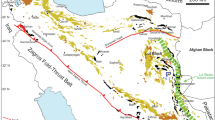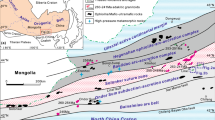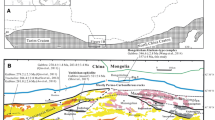Abstract
The Precambrian Dullstroom Formation of South Africa, which is predominantly composed of basaltic andesites interbedded with subordinate sedimentary and felsic volcanic strata, represents the first phase of an extended period of magmatism that was responsible for the Bushveld Magmatic Province, including the extrusive Rooiberg Group and the intrusive Bushveld Complex. New geochemical and isotopic data for the Dullstroom Formation are presented in an effort to elucidate the petrogenetic processes operative during the initiation of this magmatic episode. The volcanic units of the central portion of the Dullstroom Formation have been subdivided into at least three interbedded compositional groups: low Ti mafic to intermediate units, high-Ti mafic to intermediate units, and high Mg felsic units. High Ti and low Ti volcanic units are similar in some compositional characteristics to basalts of the nearby northern and southern provinces, respectively, of the Mesozoic Karoo continental flood basalts. Isotopic and compositional data for low Ti Dullstroom strata are consistent with bulk assimilation into a melt similar in composition to a southern Karoo basalt of 20% upper continental crust accompanied by 20% fractional crystallization of pyroxene and plagioclase. Isotopic and compositional data for high Ti Dullstroom strata are consistent with magma mixing of 30% northern Karoo K-rich basalt and 70% southern Karoo basalt followed by 20% assimilation of upper continental crust and 20% fractional crystallization of pyroxene and plagioclase. Compositions of high Mg felsic volcanic strata are consistent with 25% assimilation of a mixture of silica-rich sedimentary rock and upper continental crust into a melt similar in composition to low Ti volcanic units with 25% fractional crystallization of pyroxene and plagioclase. However, it has been suggested that compositions of these high Mg felsic strata may also be consistent with interaction of a crustal melt. Assimilation, fractional crystallization, and magma mixing that apparently affected these Dullstroom Formation volcanic strata may have occurred in a series of shallow magma chambers. These data are consistent with the suggestion that Dullstroom Formation volcanic rocks are the result of a mantle plume. Mantle plume origin also is suggested by the large volume of intrusive and extrusive strata associated with this magmatic episode. These data do not support the hypothesis that the Bushveld Complex and the Rooiberg Group formed by impacts of a cluster of comets or asteroids.
Similar content being viewed by others
Author information
Authors and Affiliations
Additional information
Received: 14 October 1998 / Accepted: 17 May 1999
Rights and permissions
About this article
Cite this article
Buchanan, P., Koeberl, C. & Reimold, W. Petrogenesis of the Dullstroom Formation, Bushveld Magmatic Province, South Africa. Contrib Mineral Petrol 137, 133–146 (1999). https://doi.org/10.1007/s004100050587
Issue Date:
DOI: https://doi.org/10.1007/s004100050587




